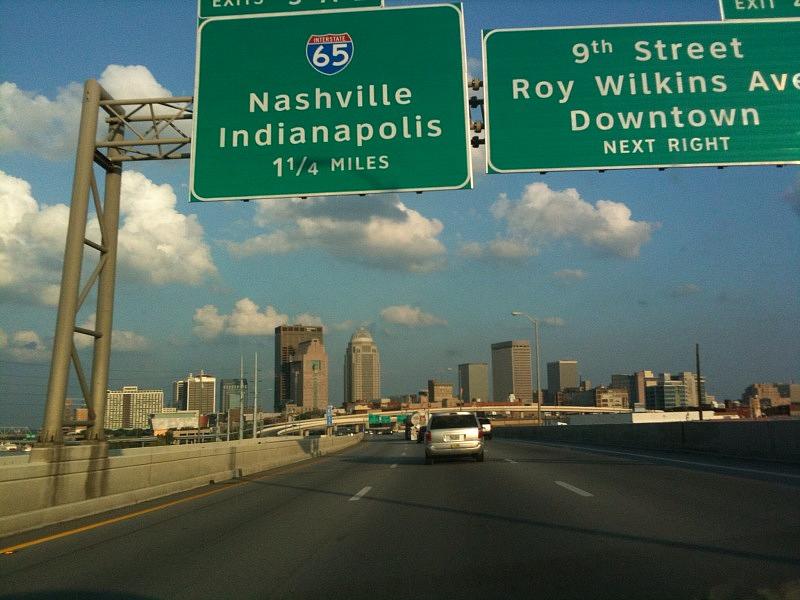Interstate Traffic Makes Air Quality in Rubbertown Worse
Erica Peterson’s month long series reporting on health issues in Rubbertown, Kentucky, for WFPL, Louisville Public Radio, was undertaken as a 2012 National Health Journalism Fellow. Stories in the series include:
Louisville's air program marks successes, but health concerns linger
Air Issues Plague Park DuValle, One of Louisville's Newest Planned Communities
Rubbertown Odor a Nuisance, But is it Illegal? Hard to Tell
Lung, Colon Cancer Rates Higher Near Rubbertown Than Other Louisville Neighborhoods
Patients, Widows, Researchers Still Dealing With Toxic Legacy of Rubbertown Chemicals
Riverside Gardens: A Former Resort Community Besieged By Pollution
Southwest Louisville Residents Still Concerned About Long-Dormant Landfill
No End in Sight for Clash Between Residents, Rubbertown Industry

Start your car. See that puff from the tailpipe in your rearview mirror? Benzene, butadiene, nitrogen oxides, carbon monoxide.
In Jefferson County, cars, trucks and planes account for about 35 percent of the volatile organic compounds in the air—that's more than factories or power plants. These vehicle emissions affect everyone in Louisville, but people who live near Rubbertown are exposed to these on top of routine emissions from the area’s industries.
Russ Barnett of the University of Louisville has been measuring VOCs in Louisville’s air for over a decade. Most emissions have dropped in the city as stricter regulations on industry have gone into effect. But not benzene.
“We’ve seen over the last 14 years almost no change in the ambient amount of benzene in the environment,” he said. “We haven’t been increasing, we haven’t been decreasing. It’s stayed pretty constant.”
Benzene is in car exhaust. It's a known human carcinogen, and long-term exposure has been linked to leukemia, anemia and fertility problems. And all of Barnett’s monitors have shown little change in the amount of benzene in the air—which indicates everyone in Louisville is being exposed about equally to high levels of the chemical.
New regulations balance increased driving
The Watterson—or the Shawnee, as it’s known here—runs directly behind a strip of newer homes on William E. Summers III Avenue in the Park DuValle neighborhood. It’s loud, and each passing car adds to the mix of chemicals in the air over West Louisville.
Cars and trucks are cleaner today than they’ve ever been. New standards finalized last year by the Environmental Protection Agency will require new cars to get on average 54.5 miles per gallon by 2025. These cars still pollute, but they travel farther on the same amount of pollution.
But Barnett says people are driving more, so for now, the benefits have been negligible .
“Keep in mind that here in Louisville we drive 24 million miles a day,” he said. “That’s the average amount of vehicle miles driven. Some of it is from Louisvillians and some of it is from people driving on 71, 65 or I-64.”
Louisville used to require yearly tests to make sure cars met minimum emissions standards. That program was scuttled in 2003. Louisville is still among a handful of areas that are federally-mandated to sell only specially-formulated gasoline.
Vehicles and ozone
The reformulated gas is blended to burn cleaner. It costs a few cents more per gallon, too. And besides reducing emissions, the gas helps cut down on ozone.
“Louisville’s always kind of had a unique relationship with ozone anyway because of the fact that we’re in a valley,” Air Pollution Control District spokesman Tom Nord said. “And also a lot of the air that comes here comes from places that are dirty, upwind power plants and things like that.”
But the nitrogen oxides in vehicle exhaust also contribute to the problem.
And now, with stricter regulations on chemical plants and power plants being phased in, cutting down on vehicle emissions may be one of the last ways to really improve Louisville’s air quality. There are public health and environmental arguments that can be made to support that, but Nord says the economic argument is there, too.
“It’s no secret that if you’re another town similar to Louisville and you’re trying to get a company to open up there, they can say ‘well, look at the ozone in that city. Look at what’s going on,’” he said. “So that’s something we just can’t have happen.”
The Air Pollution Control District reports vehicle emissions data to the EPA, but that information is based on models. Now, for the first time the Environmental Protection Agency is requiring the city to install an air monitor near a highway, so it can get actual data on the air pollution near roads. Nord says the district hasn’t decided where to place the monitor yet, but it will be installed by the end of this year.
This story was originally published in WFPL.org on January 22, 2013
Photo Credit: Jessica Erin Higgins / Wikimedia Commons

